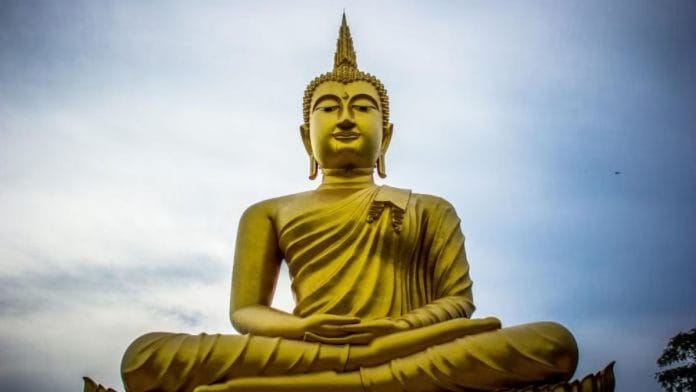Culture remains an important mainstay of Indian diplomacy. In its sojourn of cultural globalisation, material culture has formed an integral part of India’s cultural diplomacy. It is thus appropriate to mention India’s ‘relic diplomacy’ in this context. Recent cases where the relics of Lord Buddha were flown to Thailand and Queen St. Ketevan’s relics were given to Georgia have been key instances of India’s cultural diplomacy and have also signified cross-cultural communication.
Material culture, such as relics, has transcended boundaries and has come to encapsulate the culture and concept of “Vasudhaiva Kutumbakam” (The World is One Family) in the case of India.
In 1982, when the first Festival of India in the United Kingdom was held as a joint exploration between the countries and cultures, one of the important objectives of the festival was to promote a new understanding of continuity and change, the unity and plurality of Indian culture, and its ability to carry forward the India of the past into the present and the future. Nearly 200 sculptures and 135 paintings were included as part of this effort.
This exhibition had some masterpieces, such as the exhibition of banalingas and shaligramas as per Hindu culture. The four goals of life, such as Dharma (righteousness, moral values), Artha (prosperity, economic values), Kama (pleasure, love, psychological values) and Moksha (liberation, spiritual values, self-actualisation) were also depicted. The theme of enlightenment was also depicted courtesy of Lord Buddha, as were other syncretic aspects of Indian culture from Sufism.
Also read: How Hinduism incorporated Buddha and then distanced the religion
India continues to harness its shared cultural potential with ASEAN countries, with Thailand being a recent case. The revered relics of the Lord Buddha and those of his disciples, Arhant Sariputta and Arhant Maha Moggallana, are on a sacred journey from India to Thailand, where an exposition of the relics has been organised. This particular event marks the 72nd birth year of the king, Rama X, further emphasizing on the civilisational relationship between India and Thailand.
For both countries, this is a religion- and values-led cultural diplomacy in which the values of Lord Buddha and his disciples are remembered. The National Museum of Bangkok is safely housing them, from where the relics will be displayed during a 26-day exhibition. Due to the efforts of the Archaeological Survey of India (ASI), close to 20 bone fragments of Lord Buddha were excavated in the period 1971–77. It is important to note that both countries have also signed an exposition agreement for the holy relics recently. Earlier portions of this collection of sacred relics were taken to Sri Lanka in 1976 and 2012; Mongolia in 1993 and 2022; Singapore in 1994 and 2007; South Korea in 1995; and Thailand in December 1995.
Buddhism has been a strong lynchpin in India’s cultural diplomacy with the ASEAN region in particular. When former President Ram Nath Kovind visited Vietnam, he began his visit by going to the Mỹ Sơn site—a site that has a cluster of Hindu and Buddhist temples. Kovind, during his visit, stressed on the origins of Buddhism and affirmed how these aspects strengthen India’s substantive relations with ASEAN countries.
Recently, ASI also excavated five exquisite sandstone sculptures, which were a couple of Lord Buddha statues, as part of its restoration efforts for the Prohm people in Cambodia. The civilisational base for India-Thailand relations is indeed strong and enables India’s Act East policy and Thailand’s Look West policy to converge.
The second case where material culture in relics has played a crucial role in enabling India’s cultural diplomacy is in the relics of Queen St. Ketevan of Georgia. Once again facilitated by the ASI, relics of Queen St. Ketevan were returned in 2021 by the Minister of External Affairs, S. Jaishankar, on his first visit. St. Queen Ketevan is a much-admired figure and holds spiritual and inspirational importance for Georgians. A royal family member by birth, she was venerated because she underwent forced conversion to Islam but withstood it. Historical accounts state that parts of her right arm were buried in St. Augustine Church in Goa. St. Ketevan thus binds India-Georgia relations in many ways today.
In cultural diplomacy, there must be policy ends for countries to showcase the power of mutual benefit. In India’s case, Sanskriti evam Sabhyata (cultural and civilisational links) are interlinked with India’s broader political and economic goals. How relic diplomacy can substantively contribute to policy gains ought to be evaluated and perhaps unique ideas for policy ends such as in trade, connectivity, and security guarantees need to be explored.
From the future point of view of material culture—relics which play an important role in the country’s cultural diplomacy—it would be prudent to have the private sector work closely with the government. A strong, coordinated effort on the part of both will enable mutual benefits.
In relic diplomacy, there would be challenges that India must be prepared for as more countries such as Pakistan are also engaging in Buddhist diplomacy. Even though there were apprehensions about the authenticity of the effort on the part of Pakistan, India’s cultural diplomacy and strategic communication apparatus would need to factor in such cases in the times to come.
Spirituality through relic diplomacy has enabled India to come closer and put cultural diplomacy into practice. In India’s cultural diplomacy orientation, what is also apparent is the attempt of policymakers to understand what is distinctive to their own country as well as with other countries and aim to weave it together as a shared celebration. The cultural diplomacy platform on which it is laid is not to homogenise culture but to celebrate pluralism and the contributions of people like Lord Buddha and Queen St. Ketevan to humanity. Lessons from their lives are much more important now than ever.
Sudarshan Ramabadran is a policy expert, author and international communications and public diplomacy professional. Views are personal. This article was originally published on the ORF website.






